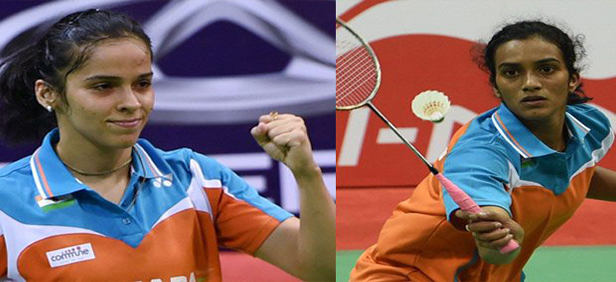Q1. Where did the game of Badminton originate?
In 1873, in one of the British colonies, it was played at a party hosted by the Duke of Beauport. It is also called Shuttle Cock. It is named after Badminton House, Duke of Beaufort's residence.
Q2. How the playing field is called and what is it's size?
Court length - 13.4 meters, -Width - 5.18 meters for singles and 6.1 meters for doubles
Q3. What is the net height?
1.55 meters / 5 feet 1 inch at the ends. 1.524 meters / 5 feet at the center.
Q4. What is a Shuttle?
Open at the top, conical in shape, with round cork base - with 16 goose feathers overlapping one another - 16 feathers shuttle cocks are used in Olympics.
Q5. How many feathered cocks are used in Olympics?
14 feathers.
Q6. How many players play the game?
Either singles or doubles.
Q7. What is the "short service line"?
1.98 meters from the center line. Service falling within this area is a foul.
Q8. With what the game of shuttle cock is played and what are it's physical features?
Rackets - Made of different graphite compounds. Types: Isometric and oval. Weight: 80-95 gms. Strings: 21 Gauge thick guts. Tension: 18 to 30 (unit of force - 80 to 130 newtons)
Q9. What is the maximum no. of points for which the game is played?
14 points.
Q10. What are all the various playing terminologies used in the game of Shuttlecock?
SERVE: To be diagonally opposite court at the start of the game or for every point serve. One serve each for singles, subject to winning a point. One serve for each player in doubles and continued by the same player upon winning a point.
LOW SERVE : Low serve into the fore court, to fall, on or just after the opponents short service line.
HIGH SERVE : A serve hit very high, the shuttle falling vertically at the back of the receiver's service court. Mostly served in singles.
FLICK SERVE : Though hit upwards, the trajectory is much shallower than the high serve.
DRIVE SERVE : Hit flat to the back of the receiver's court. Hardly used in top level tournaments.
NET SHOT : Played into the opponent's court, as close to the net as possible.
NET KILL : A shot which aims to kill the shuttle in the floor, very close to opponent's side of the net, with vertical trajectory.
LONG KILL : It is a net kill that is not so steep and travels towards the rear court. An aggressive shot played when returning a poor low serve. PUSH: Played softly into the opponents forecourt or front mid court.
CLEAR: Travels high and to the back of the opponent's rear court.
SMASH: A powerful stroke, shuttle traveling steeply downwards at great speed into the opponent's court.
JUMP SMASH : A smash where the player jumps for height, to get a steeper angle. Mostly used in doubles.
DROP SHOT : A shot played downwards into the opponent's forecourt. Usually disguised smashes. Sliced drop shot, Sliced Smash, Spinning net shot, Sliced low serve are the some of the other shots.
Q11. When was Badminton introduced in Olympics?
1992 - Olympics at Barcelona, Spain,
Q12. What are the famous ranking tournaments in Badminton?
THOMAS CUP : Named after Sir George Alan Thomas - started from 1948-19 - held once in two years.
UBER CUP : Named after Betty Uber an England player - started from 1956-57. Held once in two years for women only.
SUDIRMAN CUP : Named after Dick Sudirman, former Indonesian player and founder of Indonesian Badminton Federation. Started from 1980 May and held once in two years for mixed doubles only.
IBF (BWF) World Championship: Started in 1977 -- now known as BWF World Championships -- the periodicity of the championship underwent some changes and from 2006 it has become an annual event.
Besides these, there are very many open tournaments in various countries like England, Indonesia, Singapore, China, Japan, Thailand, Denmark, Switzerland, Hong Kong, Korea etc.,
Q13. What are the various prize- money tournaments famous and attracts top level players?
1. All England Open 2. China Open 3. Denmark Open 4. France Open 5. Hong Kong Open 6. Indonesian Open 7. Japan Open 8. Korean Open 9. Malaysian Open 10. Singapore Open 11. Sweden Open
Q14. Badminton is the national sport of which country?
Malaysia.
Q15. Who holds the record "smash speed" in Badminton?
Fu Hai Feng of China, has a record smash speed of 332 kmph on 3.6.2005 in the Sudirman Cup.
Q16. Who are the internationally famous Badminton players of India?
PRAKASH PADUKONE : Has been an active player during the late 1970s to early 1980s. Has won a number of national and international events, notably the All England Open in 1980.
PULLELA GOPICHAND : was an active Indian player during the late 1990s and Early 2000s. He is the second Indian to win the All England Open in 2001.
SAINA NEHWAL : A product of Pullela Gopichand. Presently the active Indian Player. First Indian woman to reach the quarter finals of Olympics; First Indian woman to win World Junior Champion ships, Super Series,; Held The World Rank No: 1 for brief period. Presently the Indian sensation. The only Indian player to win a medal in the olympics - Bronze - London - 2012.
P.V.SINDHU: Hyderabad -- Won the Olympic Silver Medal in Rio de Janeiro, Brazil in 2016, and has won a few open tournaments world around.
Q17. What is the World Body for Badminton?
International Badminton Federation - HQ : Kuala Lumpur, started in 1934. Now known as Badminton World Federation.
Q18. Who is the only Indian Badminton player to win an Olympic Medal in Badminton?
Saina Nehwal -- Bronze - 2012 London Olympics.
